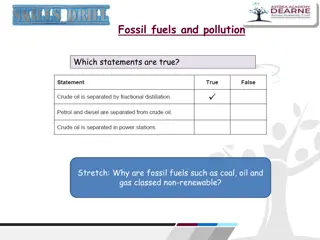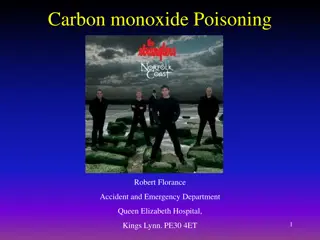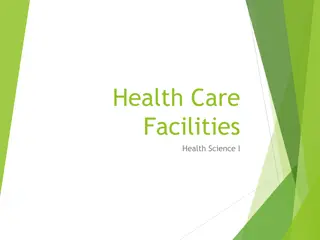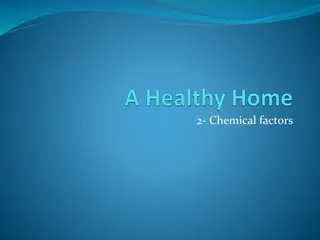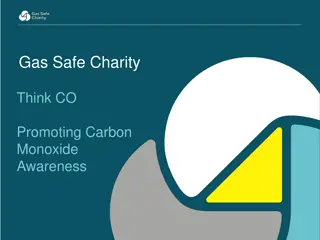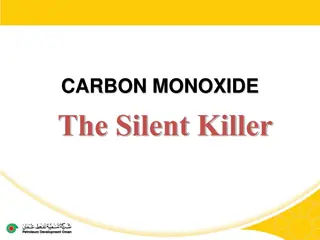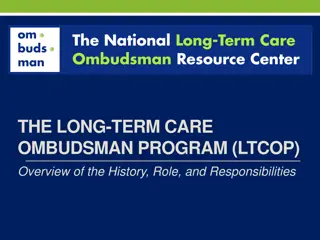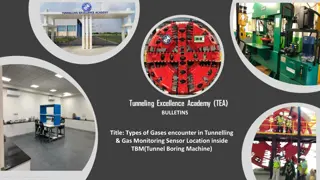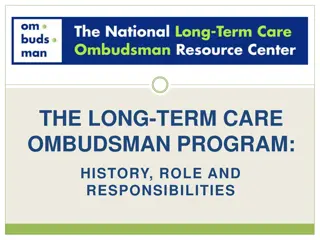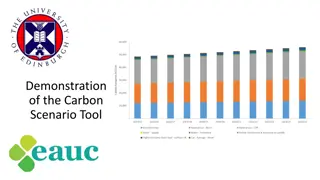Carbon Monoxide Monitoring in Long-Term Care Facilities: Risks and Response
Understanding the risks associated with carbon monoxide exposure in long-term care facilities (LTCFs) is crucial to protect the health of residents and staff. CO, a colorless and odorless gas, can lead to serious health implications, especially for those with pre-existing conditions. Monitoring and response frameworks are essential to mitigate CO-related incidents and ensure a safe environment in LTCFs.
Uploaded on Sep 11, 2024 | 0 Views
Download Presentation

Please find below an Image/Link to download the presentation.
The content on the website is provided AS IS for your information and personal use only. It may not be sold, licensed, or shared on other websites without obtaining consent from the author. Download presentation by click this link. If you encounter any issues during the download, it is possible that the publisher has removed the file from their server.
E N D
Presentation Transcript
Carbon monoxide monitoring and response in long- term care facilities (LTCFs)
Overview Carbon Monoxide What are the health risks? Who is at risk? CO in LTCFs What are the issues? What is being done to address these issues? CO Monitoring and Response Framework
CARBON MONOXIDE
CARBON MONOXIDE Typical sources of CO are(but not limited to): A gas that you cannot see, smell, or taste Fuel-burning (propane, oil, wood, gasoline) appliances Boilers Laundry equipment A combustion by- product Water heaters Fireplaces Must be monitored by a CO detector Kitchen equipment, gas-stoves Generators Exhaust from cars, delivery trucks (garages, loading bays)
CARBON MONOXIDE CO impairs oxygen delivery to cells in the body Binds tightly to hemoglobin, competing with oxygen Particularly affects high-oxygen demand organs like the heart and brain You may not experience symptoms (or not obvious) and still be exposed to unsafe CO levels Exposure to low levels of CO for long periods
What are the health risks? If inhaled at sufficient levels, for sufficient period of time
Who is at risk? Everyone, all ages Residents and staff Particularly among young, pregnant, and elderly Lower tolerance to CO Individuals with chronic lung and cardiovascular conditions are more susceptible Coronary heart disease Respiratory disease
Examples in the media Regina, Saskatchewan Fire department and gas utility provider responded to elevated CO levels detected by security and maintenance personnel. CO levels from approx. 20 to 33 ppm were reported on all three floors of the facility. Wakaw, Saskatchewan Code brown (hazardous releases) activated in response to elevated CO levels detected in a boiler room and service wing; three staff and one resident reported feeling unwell. CBC News. Carbon monoxide leak at Regina seniors residence. 2016 Available from: http://www.cbc.ca/news/canada/saskatchewan/c arbon-monoxide-regina-seniors-residence- 1.3564003 Giles, D. Code Brown alerts staff to CO leak at care home. 2013. Available from: http://globalnews.ca/news/771806/code-brown- alerts-staff-to-co-leak-at-care-home/
Background CO incident in Humboldt, Saskatchewan, 2010 Staff and residents were exposed to CO from an improperly ventilated appliance in a long- term care facility Resulted in evacuation of one wing Contributed to 3 deaths
What are the issues? CO is colourless, odourless Can only be detected through monitoring CO detectors are not routinely required to be installed, especially in older buildings Initial symptoms may be non-specific mimic other diseases (especially low-level exposure)
What are the issues? CO detectors do not alarm or notify at low levels They are designed to prevent CO poisoning (acute, high level exposure) and are not designed to prevent sub-acute exposures *Installation of CO detectors alone is not enough to mitigate this risk Residents at long-term care facilities may have conditions which make them more susceptible to the effects of low-level CO exposure (10-25 ppm)
What is being done to address CO risks in LTCFs? Saskatoon Heath Region (SHR) has developed and implemented a CO monitoring, reporting, and response framework in their LTCFs Adopted by the province of Saskatchewan in 2014 Health Canada, BC Centre for Disease Control, and National Collaborating Centre for Environmental Health were involved in evaluating the CO framework and promoting the implementation of the CO Monitoring and Response Framework in LTCFs. This work is built upon a stakeholder consultation meeting in 2013 to promote the development of a health-protective CO management framework that incorporates education, monitoring, prevention, and mitigation, with practical means to support program implementation and evaluation.
CO MONITORING AND RESPONSE FRAMEWORK
Objectives Implement a health- protective CO management framework that incorporates education, monitoring, prevention, and mitigation Enhance the capacity of health regions and LTCFs to prevent and reduce CO exposure in LTCFs Reduce the risk of harmful CO exposure among residents and staff
EDUCATION Increase staff awareness of CO health effects, sources, and importance of monitoring Train staff on established CO monitoring and response protocols
MONITORING Develop protocols for CO monitoring Installation of CO detectors near sources of CO Identify all potential sources Daily monitoring and recording of detector readings (instant and peak level) Identify elevated CO levels (>10 ppm)
REPORTING Data to be recorded on weekly log Facility Maintenance personnel Other team members as required for coverage when Facility Maintenance not available Submit weekly logs on a monthly basis to regional management Retention of monitoring records for 12 months
PREVENTION AND MITIGATION Develop resources related to identification and maintenance of CO sources Maintenance plans, schedules, etc. Perform routine maintenance on combustion appliances Establish protocols for responding to elevated CO levels Respond to elevated readings or alarms Investigate potential sources, procedures in place Mount instructions by all CO monitors Familiarize staff with procedures, including actions taken depending on level of CO
Resources BC Safety Authority Licensed gas fitters in BC http://safetyauthority.ca/contact/find-contractor Health Canada Residential Indoor Air Quality Guideline for Carbon Monoxide: http://healthycanadians.gc.ca/publications/healthy-living-vie-saine/carbon-monoxide-carbone/index- eng.php US EPA CO fact sheets (information for older adults and their caregivers) http://www2.epa.gov/healthresearch/aging-factsheets-carbon-monoxide-poisoning-prevention


